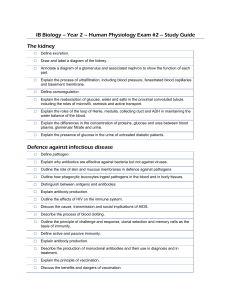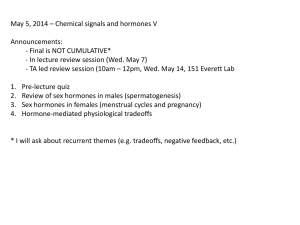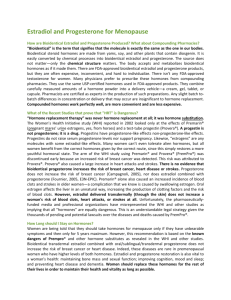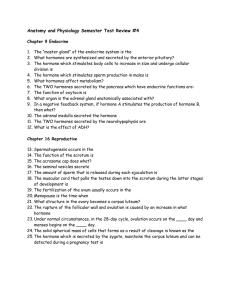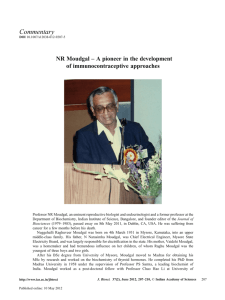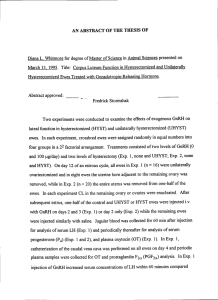A gastrovascular cavity*
advertisement
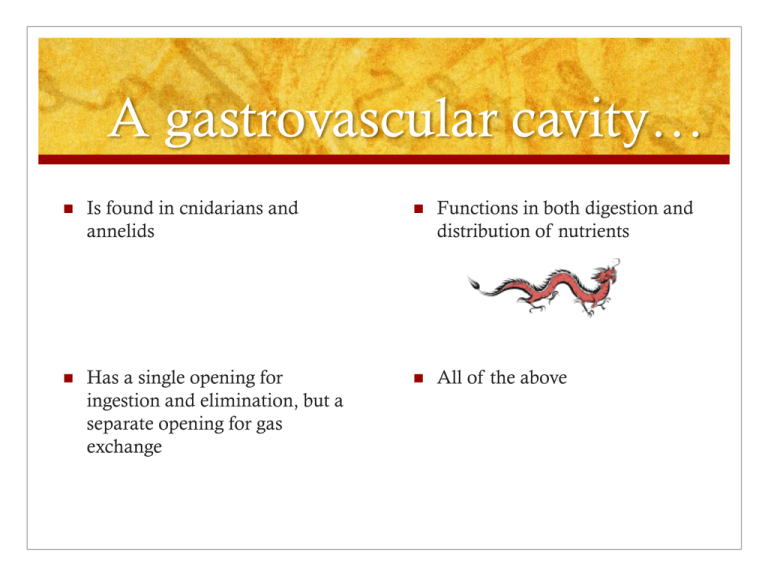
A gastrovascular cavity… Is found in cnidarians and annelids Functions in both digestion and distribution of nutrients Has a single opening for ingestion and elimination, but a separate opening for gas exchange All of the above Which of the following is NOT a similarity between open and closed circulatory systems? Some sort of pumping device helps to move blood through the body Some of the circulation of blood is a result of movements of the body The blood and interstitial fluid are distinguishable from each other All tissues come into close contact with the circulating body fluid so that the exchange of nutrients and wastes can take place A heartbeat in humans is initiated by the SA node AV node Superior and inferior vena cavae None of the above If all the body’s capillaries were open at one time… Blood pressure would fall dramatically Resistance to blood flow would increase Blood would move too rapidly through the capillary beds The amount of blood returning to the heart would increase Fibrinogen is… A blood protein that escorts lipids through the circulatory system A cell fragment involved in the blood clotting mechanism A blood protein that is converted to fibrin to form a blood clot Both B and C In countercurrent exchange… The flow of fluids in opposite directions maintains a favorable diffusion gradient along the length of an exchange surface Oxygen is exchanged for carbon dioxide Double circulation keeps oxygenated and deoxygenated blood separate The capillaries of the lung pick up more oxygen than do tissue capillaries In which vessel would blood pressure be the highest? Vena cava Pulmonary vein Right atrium Aorta In which vessel would velocity of blood flow be the lowest? Left ventricle Pulmonary capillaries Pulmonary vein Vena cava Of these structures, which would have the thickest muscle layer? Aorta Right atrium Left ventricle Vena cava The nurse tells you that your blood pressure is 112/70. What does the 70 refer to? Your heart rate The velocity of blood during diastole The systolic pressure from ventricular contraction The diastolic pressure from the recoil of the arteries Which of the following is incorrectly paired with its effect? Gastric juice – kills bacteria in the stomach Histamine – Causes blood vessels to dialate Vaccination – creates passive immunity Lysozyme – attacks cell walls of bacteria Antibodies are… Proteins embedded in T-cell membranes Proteins circulating in the blood that tag foreign cells for destruction Proteins that consist of two light and two heavy polypeptide chains B and C are both correct A secondary immune response is more rapid and greater in effect than a primary immune response because… Memory cells respond to the pathogen and rapidly clone more effector cells Chemical signals cause the rapid accumulation of phagocytic cells Helper T-cells are available to activate other blood cells The secondary response is an active immunity, whereas the primary one was a passive immunity A transfusion of type B blood given to a person who has type A blood would result in The recipient's anti-B antibodies reacting with the donated red blood cells The recipient’s B antigens reacting with the donated anti-B antibodies The recipient forming both antiA and anti-B antibodies No reaction, because B is a universal donor type of blood Which of the following destroys a target cell by phagocytosis? Neutrophil Cytotoxic T-cell Natural Killer cell Plasma cells Clonal selection is responsible for the… Recognition of class I MHC molecules by cytotoxic T-cells Proliferation of clones of effector and memory cells specific for an encountered antigen Rearrangement of antibody genes for the light and heavy chains Formation of cell cultures in the commercial production of monoclonal antibodies All of the following are involved with innate immunity except… Plasma cells Chemicals that attract phagocytes Antimicrobial proteins such as lysozymes The inflammatory response Helper T-cells play which of the following roles in an acquired immune response? Present antigens of an engulfed pathogen in its class II MHC molecules to B-cells, which are then stimulated to develop into a clone of plasma cells. Produce interferons and histamines that help initiate a specialized inflammatory response Activate both the humoral and cell-mediated immunities by releasing cytokines after recognizing class II MHC molecule-antigen complexes on an antigen-presenting cell. Bind to class I MHC molecules and activate complement proteins to attack and lyse cancer cells What accounts for the huge diversity of antigens to which B cells can respond? The antibody genes have millions of alleles The rearrangement of the antibody genes during development results in millions of possible combinations of randomly combined light and heavy polypeptide chains The antigen-binding sites at the arms of the molecule can assume a huge diversity of shapes in response to the specific antigen encountered B cells have thousands of copies of antibodies bound to their plasma membranes A freshwater fish would be expected to… Pump salt out through salt glands in the gills Produce copious quantities of dilute urine Diffuse urea across the epithelium of the gills Have scales that reduce water loss to the environment Which is the correct pathway for the passage of urine in vertebrates? Collecting tubule—Ureter— bladder--urethra Renal vein—renal ureter— bladder--urethra Nephron—urethra—bladder-ureter Cortex—medulla—bladder-ureter The process of reabsorption in the formation of urine ensures that… Excess H+ is removed from the blood Drugs and other poisons are removed from the blood Urine is always hyperosmotic to interstitial fluid Glucose, salts, and water are returned to the blood What is the mechanism for the filtration of blood within the nephron? The active transport of Na+ and glucose, followed by osmosis Both active and passive secretion of ions, toxins, and NH3 into the tubule High hydrostatic pressure of the blood forcing water and small molecules out of the capillary A lower osmotic pressure in bowman’s capsule compared to that in the glomerulus Which of the following hormones is incorrectly paired with its origins? Releasing hormones hypothalamus Growth hormone – anterior pituitary Progestins - ovary TSH - Thyroid Which of the following is an example of a positive feedback mechanism? The liver’s production of insulinlike growth factors in response to growth hormone, which promote skeletal growth The ability of the neurotransmitter acetylcholine to cause skeletal muscle to contract, heart muscle to relax, and cells of the adrenal medulla to secrete epinephrine. Prostaglandins released from placental cells promoting muscle contraction during childbirth, with muscle contractions stimulating more prostaglandin release The action of secretin on the pancreas, stimulating the release of bicarbonate Ecdysone… Is a steroid hormone produced in insects that promotes retention of larval characteristics Is involved in metamorphosis in amphibians Is a hormone secreted from specialized neurons that triggers the formation of a pupa Is secreted by prothoracic glands in insects and triggers molts and development of adult characteristics The anterior pituitary… Stores oxytocin and ADH produced by the hypothalamus Receives releasing and inhibiting hormones from the hypothalamus through portal vessels connecting capillary beds Produces several releasing and inhibiting hormones Is responsible for nervous and hormonal stimulation of the adrenal glands Which of the following hormones is not involved with increasing the blood glucose concentration? glucagon epinephrine glucocorticoids insulin Which of the following is not true of norephinephrine? It is secreted by the adrenal medulla It serves as a neurotransmitter It is part of the fight-or-flight response All of the above The function of the corpus luteum is to… Nourish and protect the egg cell Produce progesterone and estradiol Produce estradiol and disintegrate following ovulation Maintain pregnancy by production of human gonadotropin Which of the following hormones is incorrectly paired with its function? Androgens – responsible for primary and secondary male sex characteristics Oxytocin – stimulates uterine contractions during birth Estradiol – responsible for secondary female sex characteristics FSH – acts on sertoli cells that nourish sperm, promoting spermatogenesis How does meiosis differ in the production of human sperm and ova? Each meiototic division produces four sperm but only two ova Meiosis occurs in the testes of males but in the oviducts of females Primary oocytes stop dividing by mitosis before birth, whereas male stem cells continue to divide throughout life Meiosis is an uninterrupted process in males, whereas it resumes when a follicle matures and is only completed in human females when a sperm penetrates the egg cell. In what location does fertilization usually take place in a human female? Ovary Oviduct Uterus Cervix Which hormone stimulates ovulation and the development of the corpus luteum? LH FSH hCG Progesterone Which hormone is produced by the developing follicle? Estradiol Progesterone LH FSH Which hormone is produced by by the embryo and is necessary for maintaining a pregnancy? LH FSH Progesterone hCG Which hormone is produced by the corpus luteum and later by the placenta and is responsible for maintaining a pregnancy? Estradiol progesterone LH FSH Which of the following is/are involved in triggering and maintaining labor? hCG produced by the fetus Oxytocin produced by fetus and mother, and prostaglandins produced by the placenta A drop in progesterone caused by the disintegration of the corpus luteum Prolactin produced by the fetus and mother Which of the following is not true of the resting potential of a typical neuron? The inside of the cell is more negative than the outside There are concentration gradients with more sodium outside the cell and a higher potassium concentration inside the cell It is formed by the sequential opening of voltage-gated channels It results from the combined equilibrium potentials of potassium and sodium. After the depolarization of an action potential, the fall in the membrane potential occurs due to the… Closing of sodium inactivation gates Closing of potassium and sodium channels Refractory period in which the membrane is hyperpolarized Opening of voltage-gated potassium channels and the closing of sodium inactivation gates. Which of the following is incorrectly paired with its function? Axon hillock – region of neuron where action potential originates Schwann cells – create myelin sheath around axon Synapse – space between presynaptic and post-synaptic cell into which neurotransmitter is released Synaptic terminal – receptor that is part of an ion channel that is keyed to a specific neurotransmitter How is an increase in the strength of a stimulus communicated by a neuron? The spike of the action potential reaches a higher voltage The frequency of action potentials generated along the neuron increases The length of an action potential increases All action potentials are the same the nervous system cannot discriminate between different strengths of stimuli. Why is signal transmission faster in myelinated axons? These axons are thinner, and there is less resistance to the voltage flow. These axons use electrical synapses rather than chemical synapses The action potential can jump from node to node along the insulating myelin sheath. These axons are thicker and provide less resistance to voltage flow.
